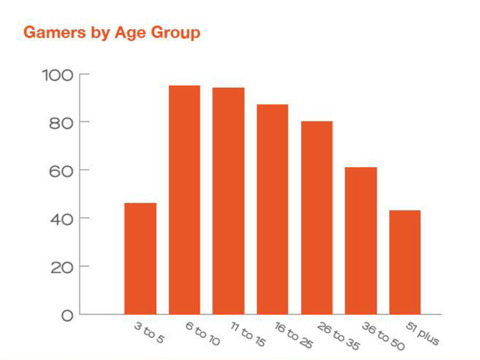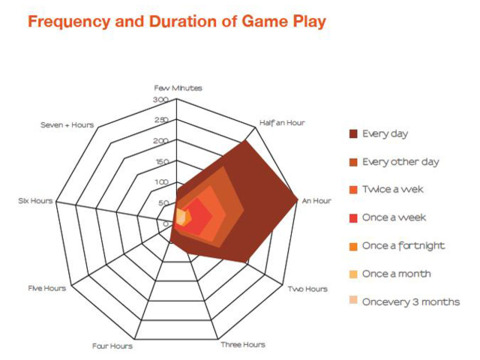DA12: Tracking the changing attitudes to gaming in Australia
In this feature, we look at some of the more comprehensive findings in the Bond University Digital Australia 2012 report.

The launch of the Digital Australia 2012 (DA12) study earlier today found that Australians are becoming increasingly familiar with games and gaming culture, from a rise in the number of households with gaming devices to the increased average age of Aussie gamers to 32.
The study, conducted by Queensland's Bond University, in conjunction with the Interactive Games and Entertainment Association (iGEA), also found that over 40 percent of Aussie gamers are now buying games online, a figure that supports the recent shift in traditional retail business models.
The DA12 report surveyed more than 3,500 Australians in 1,252 households in July this year, with the aim of tracking the changing attitudes towards digital media and gaming culture in Australia. Participants were asked 80-plus questions surrounding gaming behaviour, including average time spent playing games, parental involvement in game-buying decisions, dependence on gaming, and the role of classification markings.

The report also highlighted a number of gaming behaviours displayed by both gamers and non-gamers in Australia, including:
The average adult gamer in Australia has been playing games for 12 years.
According to most gamers, the number one and two reasons for playing games on consoles and PCs are fun and relaxation, respectively; the number one reason for playing games on mobile phones and tablets is to pass the time.
While most households contain two or more gamers, the default game experience is still single-player.
83 percent of parents of children aged under 18 play games, up from 70 percent in 2008. Most parents say they use games for education.
While parents are generally more positive about the benefits of playing games than non-parents, both groups feel that classification markings have more influence when choosing games for children than when choosing games for adults.
More experienced gamers have a different attitude towards the role of games in society than non-gamers. Gamers believe that the role of games is to relieve boredom, offer excitement, and be mentally stimulating (in that order); non-gamers believe the role of games is to relieve boredom, offer excitement, and create a gaming culture (in that order).
On the effect of interactivity on gaming, gamers believe that it offers fun and makes games interesting and stimulating (in that order); non-gamers believe that interactivity makes games violent.
Family games accounted for 19 percent of all unit sales in 2010 in Australia, followed by action titles (18 percent), first-person shooters (15 percent), and sports and racing games (9 percent each).
Nearly one in five gamers said they play social games, and one in 10 said that they play massively multiplayer games.
Female gamers in Australia now make up 47 percent of the gaming population. In 2005, female gamers accounted for only 38 percent.
The author of DA12, Dr Jeffrey Brand from Bond University in Queensland, says the report shows that games and gaming culture have become mainstream in Australia.
"The moral panic over games is over," Brand says. "At every level, from demographics to behaviours to attitudes, we see that games are understood as a normal part of our media environment. Just look at the growth of female gamers: quite simply, female gamers have begun to set the content agenda, and I think they will do so with greater effect in the coming decade. More content, more accessible platforms, and more social facilities in games has given the games market a welcome force."
Brand believes that the report also supports the growing demand for social and multiplayer games that allow people to exercise the inherent desire to play together.
"Social gaming takes gaming to a natural state in that we have played games together socially for millennia. Online technology now allows us to play games together no matter where we are. We will see a continued and even more profound move to social games over the next decade than we saw over the past decade. This doesn't mean we don't want to play against the machine, but we increasingly want to play against or with our friends, families, and acquaintances from across the world."
Brand says that one of his favourite questions while conducting the DA12 research was the question surrounding the impact of interactivity, something that he wanted to explore in order to look at the difference in beliefs between gamers and non-gamers.
"We've been asking this question since 2005. For non-gamers, interactivity is more "bad"; for gamers, it's more "good." But this has been changing. More people are playing games, and, as a result, the innovation of computer games is more obvious and understandable."
The DA12 report also found that the local Australian games industry is forecast to be worth A$2.5 billion by the year 2015, a figure that iGEA CEO Ron Curry believes is a sign that consumers are spending money in a wider variety of ways when it comes to gaming.
"There hasn't been a huge change in who is consuming interactive entertainment, but, rather, how video games are played, and on what devices," Curry says. "The DA12 report really reinforces just how ubiquitous interactive entertainment has become. Traditionally, we know people have been playing video games in the bedroom and lounge room, but, as this year's report highlights, games are now delivered anytime, anywhere, and across a myriad of mobile devices, including smartphones, tablets, handheld gaming devices on top of the traditional games console or PC."
When the first Digital Australia report was conducted in 2005, 76 percent of Australian households had a device for playing games; six years on, that figure has increased to 92 percent, something that Curry says shows that video games have become an integrated part of Australian family life.
"From all the data we are seeing, gamers are now fully part of the influential generation; hopefully we won't see the same type of government roadblock that we had with the R18+ for games decision with future gaming issues. I think the current discussion around a new classification scheme is illustrative of that."
Curry says that the figures sourced from PricewaterhouseCoopers Australian Entertainment and Media Outlook 2011-2015 also show that 50 percent of the growth in the Australian games industry will come from digital products, meaning that the growth in mobile devices and the increase in online downloads are two key contributing factors to the evolution of the local gaming industry.
"It's not all about brick and mortar purchases, or even online ordering or downloading. Consumers are now engaging in subscriptions to online environments, as well as in-game purchases, microtransactions, and other game-related spending. I also think there certainly is a place for brick and mortar stores. Consumers, particularly Australian consumers, have proven that they like the shopping experience. Retailers will need to adapt to these changes and have to look at their offerings, moving away from simple transactional retailing to more experiential offerings."
Finally, with 43 percent of those aged over 50 engaging in some sort of interactive entertainment, Curry says it's heartening to see that older Australians have also caught the gaming bug.
"Australian gamers are growing up, and they're playing video games with their children and grandchildren. How cool it is to consider that grandchildren are teaching their grandparents how to game? We're seeing a real bridging of the technology and--hopefully--the generation divide."
Got a news tip or want to contact us directly? Email news@gamespot.com


Join the conversation